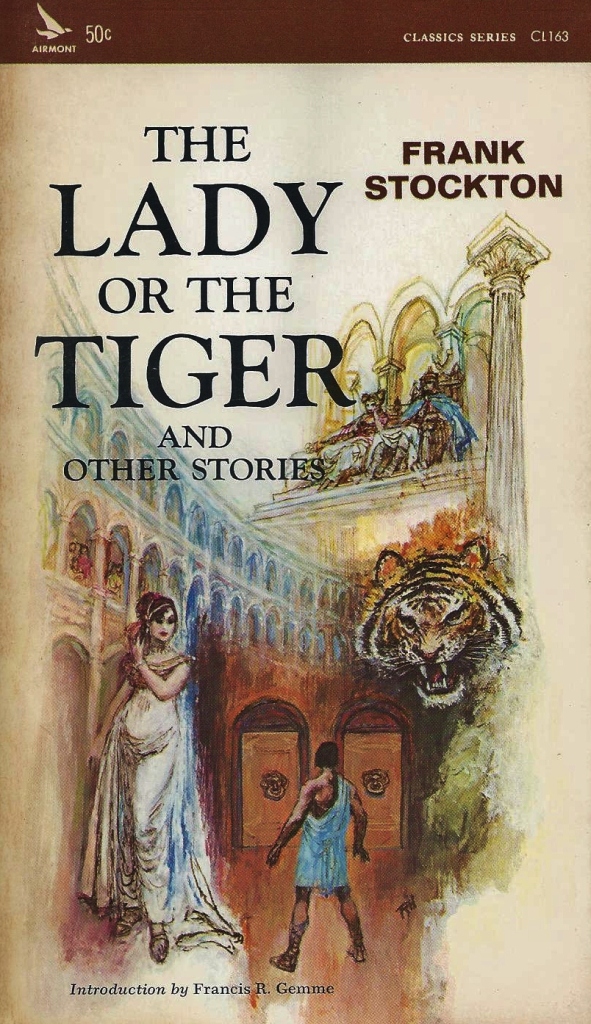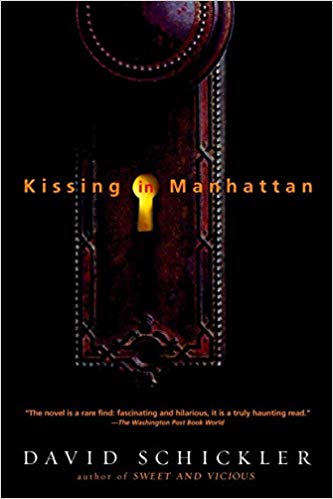
Chris Orcutt’s Favorite Short Stories
Two weeks ago, I wrote about the backstory of my short story collection The Man, The Myth, The Legend, explaining what was happening in my life at the time to inspire me to write those stories about 10 larger-than-life men from all walks of life.
This week I’d like to share some of my favorite short stories with you. Most of these I read for the first time in my teens or early 20s and have reread them dozens of times since. All of them have this in common: certain sentences make my heart pound and literally take my breath away.
These stories, and their best sentences, are what made me want to be a writer in the first place, and I’ve found that when I reread them, they give me the same rush of inspiration and aesthetic pleasure that they always have.
So, without further ado, here they are (in no particular order):
“The Lady or the Tiger?” by Frank R. Stockton

One artist’s take on the world of “The Lady or the Tiger?”
Published in The Century magazine in 1882, “The Lady or the Tiger?” has teased and tantalized readers for almost 150 years. Why has a short story had this effect on readers? Because of its deliciously ambiguous ending.
The story, actually more of a tale, is about a kingdom long ago, in which a “semi-barbaric” king metes out justice by placing the accused in an arena and having him choose one of two doors to be opened. Behind one door is a fair lady; if the accused chooses that door, he and the lady are immediately married. If, however, he chooses the other door, out springs a ravenous tiger. In this way, the king allows fate to determine justice.
One day, the king’s daughter, a beautiful princess, falls in love with a young man in the kingdom. The king finds out about it and puts him into the arena. And before the young man makes his choice, he looks to the princess for a hint about which door he should choose.
The princess responds with a deft movement of her right hand, but because we know something of the princess’ “semi-barbaric” and jealous nature, it’s unclear whether she directs her lover to the door with the lady behind it, or to the tiger.
I’m something of a pessimist, so I’ve always believed that the princess directs him to the door with the tiger. Being jealous and “semi-barbaric” like her father, she decides (in my opinion) that if she can’t have her lover, no other woman will.
My favorite sentence in this story, besides the last one (in which Stockton asks the reader which s/he thinks came out of the door, the lady or the tiger) is this one:
“The semi-barbaric king had a daughter as blooming as his most florid fancies, and with a soul as fervent and imperious as his own.”
“A Duel” by Guy De Maupassant
This story, which takes place shortly after the Franco-Prussian War, opens with these three sentences: “The war was over. The Germans occupied France. The whole country was pulsating like a conquered wrestler beneath the knee of his victorious opponent.”
I’ve loved this story since the first time I read it, back when I was 16, in sophomore English.
It’s a very short story, with a very simple plot line: a Frenchman is accosted by a Prussian soldier on a train, and when the train makes a brief stop, the Frenchman kills the soldier in a duel.
My favorite sentence in the story is actually a line of dialogue by the soldier, who says to the Frenchman,
“I’ll cut off your mustache to fill my pipe with.”
“The Short Happy Life of Francis Macomber” by Ernest Hemingway
When I was in my early 20s, I revered Hemingway’s stories, but as I’ve matured and reread them, I’ve found most of them, while clear and cleanly written, to be devoid of any real feeling.
Most of them, that is.
“The Short Happy Life of Francis Macomber” is about a wealthy man and his wife on a hunting safari with a great white hunter, Robert Wilson. Macomber reveals himself to be a coward, and there’s three-way conflict between him, his wife and the hunter (with whom she’s shared a bed during the safari). But what makes this a tour de force of a story, showing that, when he wanted to, Ernest Hemingway could do a 360-tomahawk slam dunk with the writing, is a section of the story when Hemingway goes into the mind of the lion Macomber gut-shot. The lion is hiding in tall grass as Macomber and Wilson walk in after him, and he’s marshaling all his strength for a final attack:
“All of him, pain, sickness, hatred and all of his remaining strength, was tightening into an absolute concentration for a rush.”
I should mention that Hemingway’s “Short Happy Life” partially inspired my story “The Last Great White Hunter,” in my story collection The Man, The Myth, The Legend.
“The Chaste Clarissa” by John Cheever
In this story, a rake with a Latin complexion named Baxter pursues a “red-headed, deep-breasted, slender, and indolent” young wife named Clarissa. The story has a fairytale quality about it—that of a predator pursuing innocent, beautiful, quivering prey; aspects of “Little Red Riding Hood” come to mind.
All through the story, which is told exclusively from Baxter’s POV, we see his scheming to get Clarissa into bed. Indeed, my favorite sentence in the story is one where Baxter is remarking to himself about how vulnerable Clarissa is:
“The intimations of susceptibility that came from her in the summer night were so powerful, so heady, that they convinced Baxter that here was a woman whose chastity hung by a thread.”
If you enjoy reading analyses of short stories rather than the stories themselves, check out this analysis of “The Chaste Clarissa.” It’s impressive in its detail, even though I can tell you as a fiction writer that analyzing fiction is nothing like writing it.
“To Build a Fire” by Jack London
Chances are, you had to read this story in high school English class, and it might even be one of your favorites, too. In the story, an unnamed man in the Klondike sets out in subzero weather to walk to a distant trading/trapping post. Turns out, it’s 50 degrees below zero—suicidally cold—and while walking over a stream that he thinks is frozen, the man’s feet break through, and he has to get a fire started immediately.
My favorite sentence in the story is actually a short passage of two sentences; it’s a description of the spruce tree under which the man has built his fire:
“Now the tree under which he had done this carried a weight of snow on its boughs. No wind had blown for weeks, and each bough was fully freighted.”
The image of the spruce bough “fully freighted” with snow has stuck with me for over 40 years, from the time I first read “To Build a Fire” at six years old in a copy of Jack London’s Stories for Boys my grandfather gave me. I still have this copy on the bookcase that looms over my bed. The bookcase serves as a headboard and a constant reminder of what I’ve been put here to do—write.
And anytime I’m in the woods after a heavy snowstorm, whether I’m hiking or cross-country skiing, I think of those “fully freighted” spruce boughs.
“The Smoker” and “Serendipity” by David Schickler

One version of the KISSING IN MANHATTAN cover.
Both of these stories appear in the collection Kissing in Manhattan, which came out in 2001, but I first read “The Smoker” in The New Yorker two or three years before the collection appeared.
All of the stories in the collection are interconnected, linked together in that each story features a character that lives in a Manhattan apartment building called the Preemption.
In “The Smoker,” Nicole Bonner, a senior at a private girls’ school, and her English teacher, Douglas Kerchek, fall in love. Douglas discovers that not only do the girl’s parents approve of their marrying, they’re actually pushing for it.
Back when I first read the story, I had recently left teaching high school history in Freeport, Maine, where I’d had a few whip-smart and pretty students like the character Nicole Bonner. The bizarre situation Douglas Kerchek finds himself in, and how Kerchek handles it, is both funny and riveting. My favorite sentence in the story is this:
“The Bonner penthouse was the kind of lair that nefarious urbanites like Lex Luthor occupied in films.”
Another story I love from Kissing in Manhattan is “Serendipity,” in which an ugly, middle-aged man, Leonard Bunce, lusts after his rich, gorgeous, blonde co-worker, Hannah Glorybrook.
This story is sexy. Actually, it’s the Glorybrook character who generates all of the heat, and I have to admit that certain elements of her character inspired my femme fatale, Shay Connolly, in A Real Piece of Work.
In the story, Hannah catches on to the fact that Leonard has been lusting after her, and she plays a game with him, agreeing to have sex with him if he can guess what her wealthy father does for a living. The story has a fairytale quality, like “Beauty and the Beast.” My favorite sentence in the story is this one:
“Leonard realized that this scent was something that was with Hannah always, something that she put on, and radiated, and gave like an inheritance to the world around her.”
“In the Cart” and “The Lady with the Dog” by Anton Chekhov
I could list a dozen of Chekhov’s stories among my favorites, but these two are, in my opinion, his absolute best. Why? Because Chekhov possessed the ability to make you, the reader, feel deeply with just a few words.
With a single sentence, Anton Chekhov could break the reader’s heart.
“In the Cart” (sometimes translated from the Russian as “A Journey by Cart”) is about a schoolteacher, Marya Vasilyevna, who lives in the remote Russian countryside. The action of the story takes place during her once-a-week trip to civilization. Written from her point of view, the story is filled with her musings about her wretched life, and her fantasizing about being married to a nobleman passing her cart on horseback. At one point, Marya is reflecting on the fact that her parents are dead and she has lost touch with her siblings.
Above I mentioned Chekhov’s ability to break the reader’s heart with a single sentence, and “In the Cart” provides what I consider the best example of this in all of his stories. The specificity of detail in the following sentence from the story not only breaks my heart every time I read it, but it also takes my breath away because of its genius:
“Of her former belongings her mother’s photograph was now her only possession, and this had been so faded by the dampness of the school that her mother’s features had all disappeared except the eyebrows and hair.”
Just typing that brings tears to my eyes.
“The Lady with the Dog” is my unequivocal favorite short story by any writer of any period, and I’ve read it at least 100 times.
In terms of its structure, it’s a very simple story: a middle-aged serial adulterer, Gurov, falls for a younger, married woman, Anna Sergeyevna, and what he thinks is just another fling turns into full-blown love—something his Casanova personality isn’t equipped to deal with.
There are many things that make this story a masterpiece, but to me three qualities really stand out: 1) the truly unique details, 2) the clarity of the scenes, and 3) the overall economy of the story.
When you finish “The Lady with the Dog,” you feel as though you’ve had the rich, full-bodied emotional experience of a novel. These three qualities of “The Lady with the Dog” are ones that I’ve striven to emulate in my own short stories, including the collection The Man, The Myth, The Legend, and in the chapters of my novel One Hundred Miles from Manhattan.
Every sentence in “The Lady with the Dog” is a gem, so it’s impossible for me to choose just one as my favorite. Rather, here are the three sentences that, every time I read them, literally make me gasp. Every time I read them, I resolve to try harder in my own writing:
“He could remember carefree, good-natured women who were exhilarated by love-making and grateful to him for the happiness he gave them, however short-lived; and there had been others—his wife among them—whose caresses were insincere, affected, hysterical, mixed up with a great deal of quite unnecessary talk, and whose expression seemed to say that all this was not just lovemaking or passion, but something much more significant; then there had been two or three beautiful, cold women, over whose features flitted a predatory expression, betraying a determination to wring from life more than it could give, women no longer in their first youth, capricious, irrational, despotic, brainless, and when Gurov had cooled to these, their beauty aroused in him nothing but repulsion, and the lace trimming on their underclothes reminded him of fish-scales.”
Later on, after Gurov and Anna swear never to see each other again, he goes to the city where she lives and seeks her out at the opening night of an opera:
“She seated herself in the third row of the stalls, and when Gurov’s glance fell on her, his heart seemed to stop, and he knew in a flash that the whole world contained no one nearer or dearer to him, no one more important to his happiness.”
Finally, in the concluding scene of the story, when the two of them are together again for a brief assignation, Gurov notices in the mirror that his hair has turned gray since he began the affair with Anna a few years ago. She is upset, and when he attempts to comfort her, her shoulders are warm and quivering.
“He felt a pity for this life, still so warm and exquisite, but probably soon to fade and droop like his own.”
This story has had a deep influence on my writing. You can see this influence in the chapters “Habitual Thought” and “Hummingbird’s Heartbeat” in One Hundred Miles from Manhattan, as well as the short story “The Blonde Imperative” in The Man, The Myth, The Legend.
Well, there you have it: my favorite short stories. I’m sure the second I post this piece, I’ll think of a dozen others that I should have listed, but I wanted to highlight the ones that come straight off the top of my head because those are clearly the ones that have stuck with me.
If you haven’t read some of them, may I suggest you do so right now? Here’s a link to the short story “The Lady with the Dog.” (This is the link to the 1960 Russian movie of the story on YouTube.)
And if you haven’t already, when you finish reading these stories, pick up my The Man, The Myth, The Legend, as well as One Hundred Miles from Manhattan (which chapters began their lives as short stories), and see if you can find other examples where my favorites influenced my writing.







Comments (0)